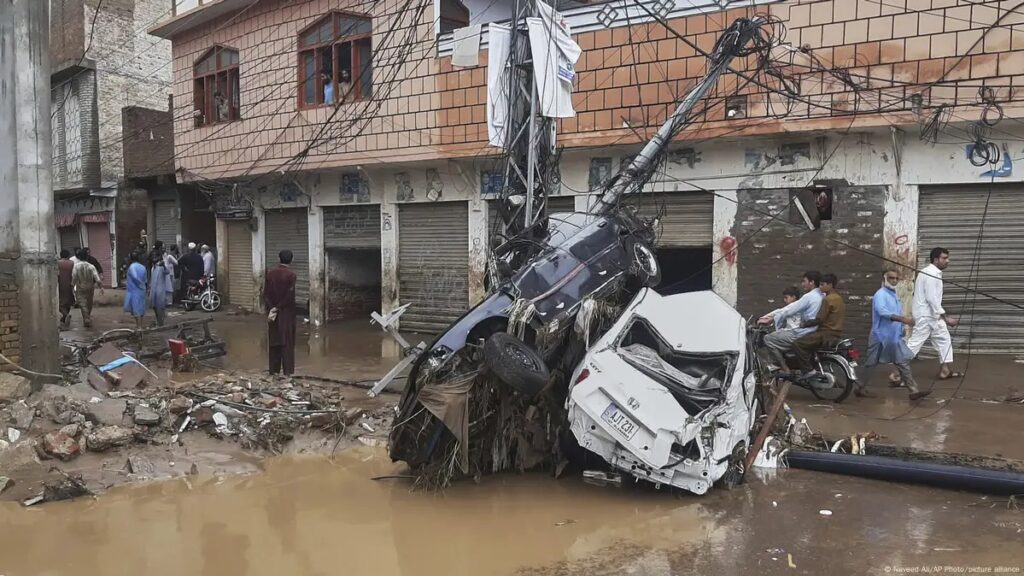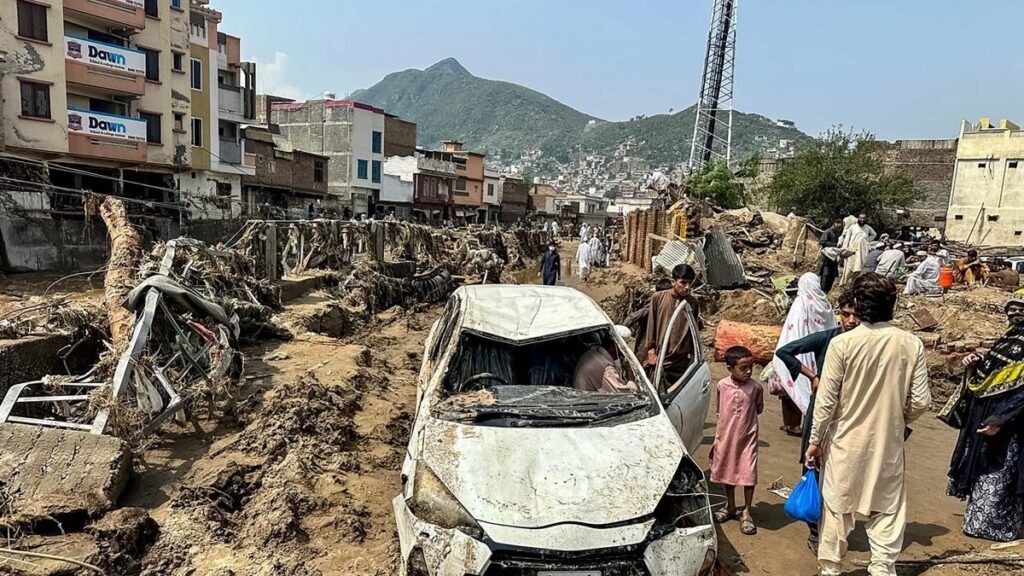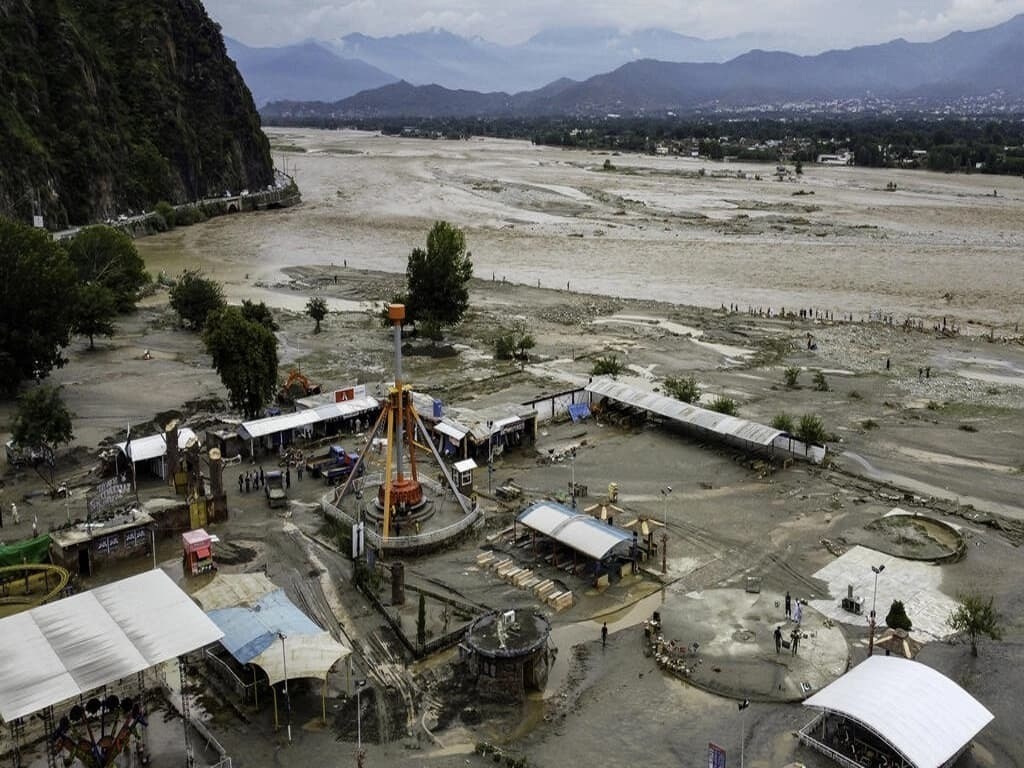Recent swat floods in Pakistan leave widespread devastation. The mountainous region of Swat Valley faced monsoon rains and cloudburst that triggered flooding. Homes, schools, hospitals, and businesses disappear under the muddy water. Infrastructure, including roads and bridges, collapses, isolating entire communities. The sheer force of the water uproots trees and carries away livestock.

2025 Swat Floods Due To Cloudburst
The 2025 monsoon season brings exceptionally heavy rainfall to the mountainous Khyber Pakhtunkhwa province. The Pakistan Meteorological Department had warned of an intensified monsoon season, and those warnings proved tragically accurate. The Swat River, fed by these torrential rains and glacial melt, swells at a rapid and alarming rate.
In late June, and again with renewed fury in August, it bursts its banks, unleashing a torrent of muddy water that rushes down the narrow valleys with destructive force. The suddenness of these “cloudbursts” leaves residents and especially tourists with little time to react. The thunderous roar of the floods is described by some as sounding like “the end of the world.”
The lives of millions stand disrupted. People are displaced from their homes, seeking refuge in makeshift camps or with relatives. They lose their possessions and their livelihoods. Access to clean drinking water and food becomes a critical challenge. The risk of waterborne diseases surges as sanitation systems fail and stagnant water accumulates. Children are particularly vulnerable, facing malnutrition and health risks.

The Pakistani government, along with international aid organizations and local volunteers, mobilizes to provide relief. Rescue operations are underway to evacuate stranded individuals. Teams work tirelessly to deliver essential supplies, including food, water, and medical aid. However, the scale of the disaster poses significant logistical hurdles. The damaged infrastructure hinders access to many affected areas.
The floods have a profound impact on the local economy, which heavily relies on agriculture and tourism. Fertile agricultural land is submerged, destroying crops and impacting future harvests. The tourism sector, a vital source of income for the region, suffers a major blow as hotels and resorts are damaged or destroyed, and access to popular tourist destinations is cut off. The long-term economic consequences for the people of Swat Valley are immense.
Climate change plays a significant role in the increased frequency and intensity of such extreme weather events. The melting glaciers in the Hindu Kush and Karakoram mountain ranges, exacerbated by rising global temperatures, contribute to increased river flows. Changes in monsoon patterns also bring heavier and more unpredictable rainfall. The swat floods serve as a stark reminder of the vulnerability of the region to the impacts of climate change.
The recovery and rebuilding process will be long and arduous. It requires significant financial resources and a coordinated effort from various stakeholders. The focus is not only on immediate relief but also on long-term rehabilitation and resilience-building measures. This includes rebuilding damaged infrastructure, providing support for livelihoods, and implementing measures to reduce the risk of future disasters.

The international community rallies to provide assistance. Countries and organizations pledge financial aid and in-kind support. The United Nations launches appeals for humanitarian assistance to address the urgent needs of the affected population. The solidarity shown by people around the world offers a glimmer of hope in the face of such devastation.
However, the scale of the disaster underscores the urgent need for greater action on climate change mitigation and adaptation. Investing in early warning systems, improving water management practices, and building more resilient infrastructure are crucial steps to protect vulnerable communities in the future. The swat floods serve as a wake-up call to the global community about the increasing risks posed by climate change.
The resilience of the people of Swat Valley shines through despite the immense suffering they endure. They support each other, sharing resources and offering comfort. Their spirit remains unbroken even in the face of unimaginable loss. The stories of courage and compassion emerging from the disaster are a testament to the strength of the human spirit.
As the waters slowly recede in some areas, the true extent of the damage becomes clearer. The task of rebuilding lives and communities begins. It is a long and challenging journey, but the determination of the people of Swat Valley, coupled with national and international support, offers hope for a better future. The memory of the floods serves as a constant reminder of the need for preparedness and proactive measures to mitigate the impact of future disasters.
The ongoing situation demands sustained attention and support. The needs of the affected population remain significant, and the long-term recovery requires a concerted and coordinated effort. The swat floods are not just a natural disaster; they are a humanitarian crisis with far-reaching consequences. The world watches as Pakistan grapples with the aftermath and works towards rebuilding the lives and livelihoods of the people of Swat Valley.
External Links:
- National Disaster Management Authority (NDMA) Pakistan: https://www.ndma.gov.pk/
- United Nations Office for the Coordination of Humanitarian Affairs (OCHA): https://www.unocha.org/
- International Federation of Red Cross and Red Crescent Societies (IFRC): https://www.ifrc.org/
- UNHCR, the UN Refugee Agency: https://www.unhcr.org/
- World Food Programme (WFP): https://www.wfp.org/



